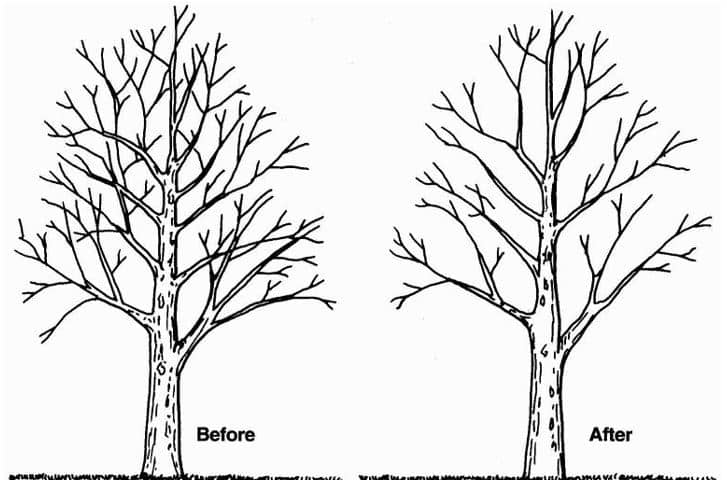Crown thinning is a pruning technique that removes some of the smaller branches from the outer part of the crown, promoting evenly spaced branches and foliage throughout the tree. This allows light and wind to pass through non-coniferous trees, such as birch, oak, cherry and sycamore.

Crown thinning is a technique used to selectively remove branches from the top and sides of a tree in order to reduce its overall density. This practice is particularly beneficial for large trees, as it can help to improve their health and safety, while also maintaining their natural shape and beauty.
One of the main benefits of thinning out a crown for large trees is that it can help to improve their overall health. When a tree’s crown is too dense, it can cause a number of problems, such as shading out other plants, overcrowding, and rubbing branches.
Thinning a tree crown can help to promote better air circulation and sunlight penetration, which can help to improve the tree’s overall health and vigour. Additionally, by removing some of the branches, thinning can help to reduce the weight on the tree’s main structure and make it less susceptible to damage from strong winds and storms.
Another benefit of thinning large trees is that it can help to improve the safety of your property. Overgrown trees can be more susceptible to wind damage, and overhanging branches can be a potential hazard for vehicles and pedestrians. Crown reduction and thinning can help to reduce the risk of damage or injury by removing branches that pose a risk.
Crown thinning also helps to improve the appearance of large trees. A well-shaped and balanced crown can enhance the aesthetic appeal of your property and increase its curb appeal. By removing some of the branches, crown thinning can help to create a more natural and pleasing shape that is in harmony with its surroundings.
It is important to note that crown thinning should only be performed by a certified arborist, as it can be dangerous to perform on your own and if not done correctly it can damage the tree. An arborist will also have the knowledge and expertise to determine which branches should be removed and which should be left intact, in order to maintain the tree’s health and structure.
Where crown thinning comes into its own is where it manages to keep the tree from storm damage. In high winds the tree has to flex with the wind and captures the force of the wind in its canopy. I call this the sail effect some oak trees can have a much as 200 tonnes of force exerted on the trunk. Thinning the tree reduces the force that is exerted on the tree.
Also as a process of pruning the tree starts to produce more juvenile growth. Juvenile growth is good because it usually means there is is more vigor and vitality in the tree. More vigor and vitality in the tree means the tree is more likely to remain pest and disease free. Also juvenile growth has more flex in windy conditions and reduces the likelihood of a branch snapping off because it had become brittle.
In conclusion, crown thinning is an important tree maintenance technique that can help to improve the health, safety, and appearance of large trees. Regular tree crown reduction and thinning can help to ensure that your large trees remain healthy, safe, and beautiful for years to come. It is a necessary step in maintaining the overall health of the tree, while also preserving its natural shape and beauty.
For more information please click here https://www.rhs.org.uk/plants/types/trees/near-buildings
WHEN PRUNED CORRECTLY BY AN EXPERIENCED TREE SURGEON, CROWN THINNING CAN OPEN UP THE AREA AROUND THE TREE AND PROMOTE GOOD LIGHT TRANSMISSION.

Mon – Fri: 8am – 8pm
Saturday: 9am – 7pm